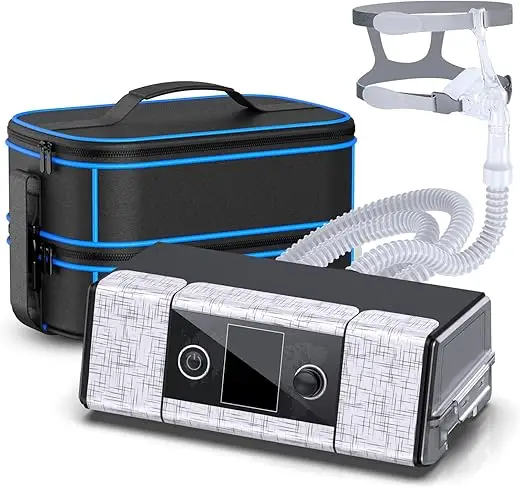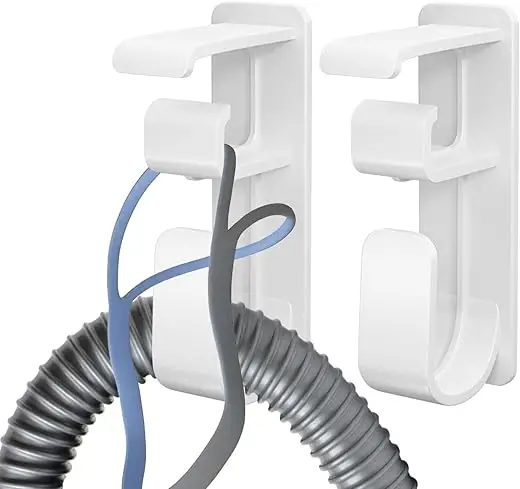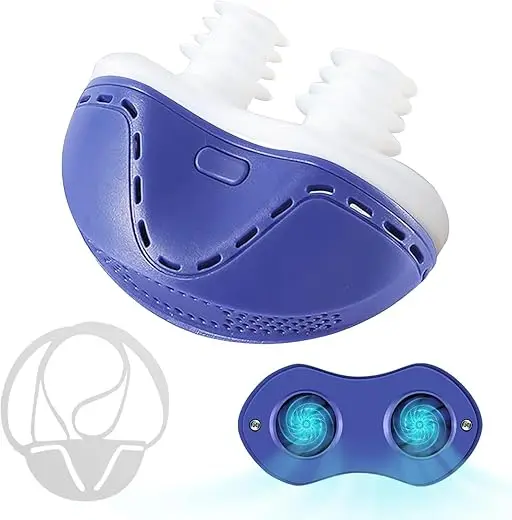The Quiet Killer: When Sleep Apnea Doesn’t Announce Itself
You’ve heard about sleep apnea – the loud snoring, the gasping for air, the partner who can’t sleep through the racket. But what if you have sleep apnea and nobody knows it, not even you? Silent sleep apnea, also called “quiet” sleep apnea, affects millions of people who never seek treatment because they don’t have the classic symptoms. They don’t snore loudly. Their partners sleep peacefully beside them. Yet their bodies are fighting for oxygen all night long.
This hidden form of sleep apnea is particularly dangerous because it can go undetected for years, even decades, silently damaging your heart, brain, and metabolic system. By the time obvious symptoms appear, significant health damage may have already occurred. This comprehensive guide will reveal the subtle signs of silent sleep apnea that even your doctor might miss.
Understanding Silent Sleep Apnea: Why It Stays Hidden
Silent sleep apnea occurs when breathing interruptions happen without the dramatic sound effects. The airway still closes, oxygen levels still drop, and the brain still jolts the body awake – but it all happens quietly. Think of it as a stealth attack on your health.
Why some people have silent sleep apnea:
- Partial rather than complete airway obstruction
- Central sleep apnea (brain-based) rather than obstructive
- Body position keeps airway partially open
- Anatomical differences in throat structure
- Lower body weight (thin people can have sleep apnea too)
- Female anatomy often leads to quieter symptoms
- Age-related changes in throat muscles
The danger lies in the assumption that no snoring means no problem. Research shows that up to 20% of sleep apnea cases involve minimal or no snoring, yet these silent sufferers face the same health risks as their snoring counterparts.
The Subtle Symptoms: Your Body’s Quiet Cries for Help
Morning Mysteries: Waking Up Wrong
The Unexplained Morning Exhaustion You went to bed at a reasonable hour. You “slept” for eight hours. Yet you wake up feeling like you pulled an all-nighter. This isn’t normal tiredness – it’s a bone-deep exhaustion that coffee can’t fix. Your body spent the night in survival mode, repeatedly yanking you from deep sleep to breathe, even if you never fully woke up.
The Mysterious Morning Headache A dull, pressing headache greets you most mornings, typically affecting both sides of your head. It usually fades within an hour or two. These headaches result from carbon dioxide buildup and oxygen deprivation during the night – your brain’s way of saying it didn’t get enough oxygen.
Dry Mouth Without Explanation You wake up with a desert in your mouth, despite staying hydrated and having no obvious reason for mouth breathing. Your body unconsciously opens your mouth seeking more air, leading to severe dryness that water before bed won’t prevent.
The Foggy First Hour Morning confusion that goes beyond typical grogginess. You might struggle to remember what day it is, feel disoriented, or need significant time to feel mentally “online.” This isn’t just being “not a morning person” – it’s your brain recovering from oxygen deprivation.
Daytime Deceptions: Hidden Struggles
Fatigue Disguised as Aging or Stress “I’m just getting older” or “Work is stressful” become your explanations for constant tiredness. But this fatigue is different – it’s unrelenting, doesn’t improve with rest, and affects you even during relaxing vacations. Silent sleep apnea fatigue feels like wearing a heavy coat you can never take off.
Concentration Collapse You find yourself reading the same paragraph three times. Meetings become a struggle to focus. Tasks that once took minutes now take hours. Your brain, deprived of restorative sleep, can’t maintain attention like it used to. Many people blame age, stress, or even early dementia, never suspecting sleep apnea.
Memory Gaps and Mental Mistakes Forgotten appointments, misplaced items, inability to recall conversations – these memory lapses multiply. You might walk into rooms forgetting why, lose your train of thought mid-sentence, or struggle to learn new information. Sleep deprivation prevents your brain from properly consolidating memories.
Mood Swings Without Obvious Cause Irritability creeps in. Small annoyances trigger big reactions. Depression or anxiety appear without clear triggers. Your emotional regulation system, exhausted from poor sleep, can’t maintain balance. Partners might notice you’ve become “difficult” or “moody” without understanding why.
Physical Symptoms: The Body Keeps Score
Unexplained Weight Gain Despite no change in diet or exercise, pounds accumulate, especially around your midsection. Sleep apnea disrupts hormones controlling hunger (ghrelin) and satiety (leptin), making you hungrier and less satisfied after eating. Your metabolism slows, and your body stores more fat, particularly dangerous visceral fat.
High Blood Pressure That Won’t Budge Your doctor keeps adjusting medications, but your blood pressure remains stubbornly high. Silent sleep apnea causes repeated stress responses throughout the night, keeping your cardiovascular system in constant overdrive. This “resistant hypertension” is often the first clinical sign that leads to sleep apnea discovery.
Frequent Nighttime Urination You wake up two, three, even four times to urinate, assuming it’s age, prostate issues, or drinking too much water. In reality, the breathing interruptions trigger a complex hormonal cascade that increases urine production. Your body is trying to reduce fluid volume to ease the strain on your struggling cardiovascular system.
Acid Reflux and GERD Nighttime heartburn becomes your unwelcome companion. The breathing efforts during apnea events create pressure changes that pull stomach acid upward. You might wake with a sour taste, throat irritation, or chronic cough, never connecting it to breathing problems.
Decreased Libido and Sexual Dysfunction Interest in intimacy wanes. Men may experience erectile dysfunction; women might have difficulty with arousal. The combination of exhaustion, hormonal disruption, and reduced oxygen affects sexual health profoundly. Many suffer in silence, embarrassed to discuss these changes.
Cardiovascular Clues: Your Heart’s Silent Struggle
Irregular Heartbeat (Arrhythmia) You might feel heart palpitations, fluttering, or skipped beats, especially at night or upon waking. The oxygen drops and stress responses of silent sleep apnea directly affect your heart’s electrical system, potentially leading to atrial fibrillation.
Night Sweats Without Fever Waking up drenched in sweat, requiring pajama or sheet changes, despite comfortable room temperature. Your body’s fight-or-flight response to breathing interruptions triggers excessive sweating. This isn’t menopause or normal temperature regulation – it’s your body’s panic response to oxygen deprivation.
Chest Discomfort A vague chest pressure or discomfort, especially when lying down, that doesn’t quite feel like classic heart problems. The strain on your cardiovascular system from repeated oxygen drops can cause chest symptoms that are easy to dismiss or attribute to other causes.
Gender Differences: Why Women’s Silent Sleep Apnea Goes Undiagnosed
Women are particularly susceptible to silent sleep apnea, with symptoms often dismissed as hormonal, emotional, or age-related changes.
Women-Specific Silent Symptoms:
- Insomnia rather than excessive sleepiness
- Anxiety and depression as primary complaints
- Restless legs syndrome
- Morning headaches more than men
- Fatigue described as “exhaustion” not “sleepiness”
- Symptoms worsen during menstruation, pregnancy, and menopause
- More likely to have REM-related sleep apnea (silent during most of night)
- Hypothyroidism symptoms that don’t improve with treatment
Why Women Get Missed:
- Doctors less likely to suspect sleep apnea in women
- Sleep studies historically based on male symptoms
- Women more likely to attribute symptoms to other causes
- Partners less likely to report women’s snoring
- Different fat distribution affects airway differently
The Dangerous Misconceptions About Silent Sleep Apnea
Myth 1: “Thin People Don’t Get Sleep Apnea”
While obesity is a risk factor, 20% of people with sleep apnea have normal BMI. Silent sleep apnea particularly affects thin people with:
- Small or recessed jaw (retrognathia)
- Narrow airway
- Large tongue relative to mouth size
- Deviated septum
- Chronic nasal congestion
Myth 2: “I Don’t Snore, So I Can’t Have Sleep Apnea”
Studies show up to 20% of sleep apnea patients don’t snore significantly. Central sleep apnea, in particular, often presents without snoring. Even obstructive sleep apnea can be quiet if:
- Obstruction is partial
- Person sleeps on their side
- Airway anatomy creates less vibration
- Partner is a heavy sleeper who doesn’t notice mild snoring
Myth 3: “I’d Know If I Stopped Breathing”
Most people have no awareness of breathing interruptions. Your brain pulls you from deep sleep just enough to resume breathing but not enough to form a memory. You might have 30 breathing interruptions per hour and remember none of them.
Myth 4: “Young People Don’t Get Sleep Apnea”
While risk increases with age, young adults and even teenagers can have silent sleep apnea, especially with:
- Family history
- Jaw abnormalities
- Enlarged tonsils or adenoids
- Chronic allergies
- PCOS in young women
Risk Factors Specific to Silent Sleep Apnea
Beyond traditional risk factors, silent sleep apnea is more likely with:
Anatomical Factors:
- Narrow airway naturally (genetic)
- Small lower jaw or receding chin
- High, narrow palate
- Large tongue or tongue that falls back easily
- Enlarged turbinates in nose
- Chronic nasal congestion from allergies
- Deviated septum
Medical Conditions:
- Hypothyroidism (even when treated)
- PCOS (polycystic ovary syndrome)
- Chronic fatigue syndrome
- Fibromyalgia
- Autoimmune conditions
- Chronic sinusitis
- Anxiety and depression
Lifestyle Factors:
- Alcohol use (relaxes throat muscles)
- Sedative medications
- Sleeping on back
- Chronic stress (affects muscle tone)
- Shift work (disrupts circadian rhythms)
The Hidden Health Consequences: What’s Happening While You “Sleep”
Brain Damage Accumulating Silently
Each night of interrupted breathing causes micro-damage to your brain:
- Gray matter loss in areas controlling memory and executive function
- White matter changes similar to small strokes
- Increased amyloid plaques (Alzheimer’s marker)
- Reduced brain volume over time
- Impaired blood-brain barrier function
Studies show that even mild, silent sleep apnea can cause measurable brain changes within two years.
Metabolic Mayhem
Silent sleep apnea wreaks havoc on your metabolism:
- Insulin resistance develops (pre-diabetes)
- Leptin resistance (always hungry)
- Cortisol dysregulation (stress hormone)
- Thyroid function disruption
- Growth hormone suppression
- Inflammation markers increase
This metabolic dysfunction often appears years before obvious symptoms, slowly undermining your health.
Cardiovascular Countdown
Your heart and blood vessels suffer progressive damage:
- Endothelial dysfunction (blood vessel damage)
- Increased clotting risk
- Atherosclerosis acceleration
- Left ventricular hypertrophy (thickened heart muscle)
- Pulmonary hypertension risk
- 23% increased risk of sudden cardiac death
The scariest part? This damage occurs even with mild, silent sleep apnea.
Self-Assessment: Could You Have Silent Sleep Apnea?
The Silent Sleep Apnea Screening Checklist
Rate each symptom: Never (0), Sometimes (1), Often (2), Always (3)
Morning Symptoms:
- [ ] Wake up tired despite “adequate” sleep
- [ ] Morning headaches
- [ ] Dry mouth or sore throat
- [ ] Difficulty getting going in the morning
- [ ] Morning confusion or disorientation
Daytime Symptoms:
- [ ] Unexplained fatigue
- [ ] Difficulty concentrating
- [ ] Memory problems
- [ ] Mood changes or irritability
- [ ] Falling asleep during quiet activities
Physical Symptoms:
- [ ] Unexplained weight gain
- [ ] High blood pressure
- [ ] Frequent nighttime urination
- [ ] Night sweats
- [ ] Decreased libido
Risk Factors:
- [ ] Family history of sleep apnea
- [ ] Small or receding jaw
- [ ] Chronic nasal congestion
- [ ] Neck circumference >16″ (women) or >17″ (men)
- [ ] Post-menopausal (women)
Score Interpretation:
- 0-10: Low risk (but don’t ignore symptoms)
- 11-20: Moderate risk (discuss with doctor)
- 21-30: High risk (seek sleep evaluation)
- 31+: Very high risk (prioritize sleep study)
Home Testing Options
Before seeing a doctor, you can gather evidence:
Overnight Oximetry:
- Purchase or rent a recording pulse oximeter
- Wear overnight for several nights
- Look for oxygen drops below 90%
- Document patterns of desaturation
Sleep Apps and Wearables:
- Apps that record breathing sounds
- Smartwatches tracking heart rate variability
- Sleep position monitors
- Movement trackers showing restlessness
Partner Observation Sheet: Even with silent sleep apnea, partners might notice:
- Shallow or irregular breathing
- Long pauses between breaths
- Slight gasping or sighing
- Restless movement patterns
- Position changes seeking better breathing
Getting Diagnosed: Advocating for Yourself
Overcoming Medical Bias
Many doctors don’t suspect sleep apnea without classic symptoms. Be prepared to:
Document Everything:
- Keep a detailed symptom diary for 2-4 weeks
- Track energy levels on a 1-10 scale
- Note timing of symptoms
- Record any breathing observations
- Document impact on daily life
Use Specific Language: Instead of “I’m tired,” say:
- “I have unrefreshing sleep despite adequate hours”
- “I experience excessive daytime fatigue affecting my work”
- “I have multiple cardiovascular risk factors without clear cause”
- “My partner notices irregular breathing patterns”
Request Specific Tests:
- Ask for overnight oximetry as a screening tool
- Request home sleep apnea test (HSAT) even if doctor is skeptical
- Consider paying out-of-pocket if insurance requires classic symptoms
- Ask for referral to sleep specialist if primary care dismisses concerns
Types of Sleep Studies for Silent Sleep Apnea
Home Sleep Apnea Test (HSAT):
- Measures breathing, oxygen, heart rate
- Good for detecting moderate to severe OSA
- May miss mild or REM-only sleep apnea
- More likely to get insurance coverage
In-Lab Polysomnography (PSG):
- Comprehensive monitoring including brain waves
- Can detect all types and severities
- Better for silent/central sleep apnea
- Shows sleep architecture disruption
Multiple Sleep Latency Test (MSLT):
- Measures daytime sleepiness objectively
- Helpful when fatigue is primary symptom
- Can support sleep apnea diagnosis
Treatment Success: Addressing Silent Sleep Apnea
CPAP Therapy Considerations
Silent sleep apnea often requires different CPAP approach:
- Lower pressure settings may be sufficient
- Nasal masks often work better than full-face
- Auto-adjusting machines (APAP) particularly helpful
- Pressure relief features improve comfort
- May need different settings for REM sleep
Alternative Treatments for Mild Cases
Oral Appliances:
- Particularly effective for jaw-related silent sleep apnea
- Custom-fitted by dentist
- Advances lower jaw forward
- Good option for travel
Positional Therapy:
- Side-sleeping devices
- Wedge pillows
- Adjustable beds
- Tennis ball technique (prevents back sleeping)
Lifestyle Modifications:
- Weight loss (even 10% can help)
- Avoid alcohol and sedatives
- Treat nasal congestion aggressively
- Stress reduction techniques
- Regular exercise (improves muscle tone)
Emerging Treatments
Hypoglossal Nerve Stimulation:
- Implanted device stimulates tongue muscles
- Prevents airway collapse
- Good for specific anatomical types
Nasal EPAP Devices:
- Disposable valves create positive pressure
- Good for mild silent sleep apnea
- Portable and discreet
Living with Silent Sleep Apnea: Practical Strategies
Energy Management
While pursuing treatment, manage symptoms:
- Strategic napping (20 minutes maximum)
- Consistent sleep schedule
- Morning light exposure
- Avoid afternoon caffeine
- Break tasks into manageable chunks
- Prioritize important activities for peak energy times
Cognitive Support
Combat brain fog:
- Use lists and reminders religiously
- Implement organizational systems
- Take notes during conversations
- Use calendar alerts for everything
- Create routine to reduce decision fatigue
- Consider cognitive behavioral therapy
Relationship Navigation
Silent sleep apnea affects relationships:
- Educate partner about invisible symptoms
- Communicate about mood changes
- Plan intimate time when energy is highest
- Be open about sexual health impacts
- Consider couples counseling if needed
The Recovery Timeline: What to Expect with Treatment
Immediate Improvements (Days to Weeks)
- Morning headaches disappear
- Nighttime urination decreases
- Morning alertness improves
- Mood stabilizes
- Night sweats reduce
Short-Term Benefits (1-3 Months)
- Energy levels increase significantly
- Concentration and memory improve
- Blood pressure begins dropping
- Weight loss becomes easier
- Libido starts returning
Long-Term Healing (6-12 Months)
- Metabolic markers normalize
- Cardiovascular risk decreases
- Brain fog clears completely
- Depression/anxiety symptoms improve
- Quality of life transforms
Ongoing Protection (1+ Years)
- Reduced risk of heart disease and stroke
- Decreased dementia risk
- Improved longevity
- Better immune function
- Enhanced overall health
Taking Action: Your Silent Sleep Apnea Action Plan
Week 1: Observation and Documentation
- Complete symptom checklist
- Start sleep/symptom diary
- Purchase overnight oximeter if possible
- Enlist partner’s help in observation
- Research sleep specialists in your area
Week 2-3: Medical Preparation
- Schedule doctor appointment
- Compile medical history
- List all symptoms and impacts
- Prepare questions
- Gather any home monitoring data
Week 4: Medical Consultation
- Present documented symptoms
- Request sleep study
- Discuss risk factors
- Ask about testing options
- Get referral if needed
Ongoing: Treatment and Recovery
- Pursue recommended testing
- Start treatment promptly
- Track improvements
- Adjust treatment as needed
- Celebrate progress
Conclusion: Breaking the Silence
Silent sleep apnea is a thief that operates in darkness, stealing your health, energy, and quality of life without announcing its presence. But now you know its calling cards – the subtle symptoms that whisper rather than shout. You understand that absence of snoring doesn’t mean absence of danger.
The most important message is this: trust your body. If you feel something is wrong, if you’re exhausted without explanation, if your health is declining without clear cause – investigate sleep apnea, even if you don’t fit the classic profile. Too many people suffer for years, even decades, because they or their doctors didn’t recognize the quiet symptoms.
Treatment for silent sleep apnea can be life-changing. Patients often say they didn’t realize how bad they felt until they experienced how good they could feel. The fog lifts, energy returns, and life becomes vibrant again.
Don’t let silent sleep apnea remain hidden. Your health, your relationships, and your future depend on bringing this condition into the light. The silence has lasted long enough – it’s time to speak up for your sleep and reclaim your life.
Remember: If you recognize these symptoms in yourself or a loved one, don’t wait. Silent sleep apnea may be quiet, but its health consequences are loud and clear. Seek evaluation and treatment – your body will thank you.



